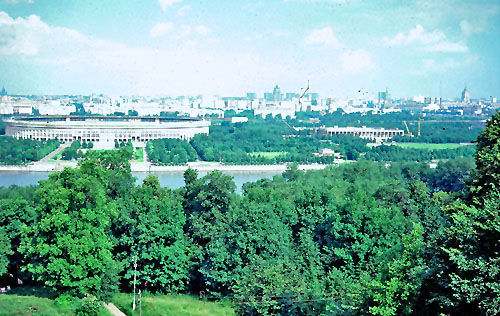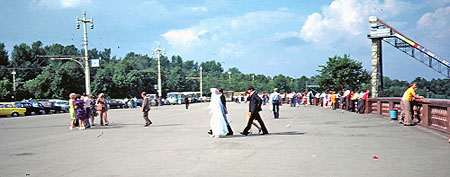
View of Moscow from the Sparrow Hills
Two years after the disaster of the Decembrist Uprising (and just a little over a year after the executions of the leaders), in the summer of 1827, two young boys, Aleksandr Herzen, then fifteen-years-old (1812-1870), and Nikolai Ogarev, thirteen-years-old (1813-1877), stood on the hill pictured above and swore an oath to avenge the Decembrists. As recalled later by Herzen (My Past and Thoughts, vol.1, p. 69),
Flushed and breathless, we stood there mopping our faces. The sun was setting, the cupolas glittered, beneath the hill the city extended farther then the eye could reach; a fresh breeze blew on our faces, we stood leaning against each other and, suddenly embracing, vowed in sight of all Moscow to sacrifice our lives to the struggle we had chosen.
That's pretty amazing to me. Both Herzen and Ogarev along with their friend Mikhail Bakunin (1814-1876) eventually played a central role in the intellectual developments in Russia in the 1830s and 1840s that led Pavel Annenkov (1814-1887) to term that time as an "Extraordinary Decade" in his memoirs. Later Isaiah Berlin, the British intellectual historian, wrote of this period in Russian history as "The Remarkable Decade."
Slavophiles
The Slavophiles were champions of the Russian Orthodox church and the autocracy, and they believed that Russia was wrong to follow the path of other European countries--The Slavophiles tended to viscerally denounce Peter the Great's effort at making Russia into a "European" country.--Instead, Russia should follow its own unique, and, of course, superior, Slavic, Russian path. According to the Slavophiles, the village community, or commune, (mir or obshchina), and the legendary popular assembly, the zemskii sobor, were the key features of Russian civilization. (This was, to say the least, a somewhat idealized version of some institutions that never quite lived up to their democratic pretensions). The mir, in particular, was said to possess the Slavic characteristic of sobornost' (соборность) which could be loosely translated as "togetherness" or "community togetherness spirit." Most of the Slavophiles viewed the village commune as the embodiment of this sobornost' and imagined the beauty of the life of the Russian peasant living in this harmonious "community togetherness spirit." (The reality was far different. Who, in their right mind, ever wanted to be a serf? Certainly not any Russian peasants.)
You should realize that the Slavophile viewpoint was heavily influenced by concepts borrowed from Romanticism, especially ideas about how wonderful the life lived close to nature could be. Finally, while the Slavophiles tended to support the autocracy, they also supported the emancipation of the serfs and freedoms of speech and press. Key figures in the movement included Aleksei Khomiakov (1804-1860)--Khomiakov once wrote that the Westernizers were "sick Russians, afflicted by a foreign disease more deadly than syphilis." (www.benadorassociates.com/article/10110)--Konstantin Aksakov (1817-1860), a Russian literary critic, and his brother, Ivan Aksakov (1823-1886), also a littérateur and later publicist for the ideas of the Slavophiles; and Ivan Kirevskii (1806-1856).
Conservatives
Let's draw a fine line between Slavophiles and Conservatives with the distinction being that Conservatives were staunch supporters of the tsarist regime whereas Slavophiles did advocate some changes in the tsarist regime. The Conservatives would have included Sergei Uvarov, minister of education for Tsar Nicholas I, and the originator of the ideology of Official Nationality. Some historians may quibble, but I would also consider to be conservative intellectuals and defenders of the autocracy: Mikhail Pogodin (1800–1875), professor of Russian history at the University of Moscow and co-publisher of the journal Moskvitianin (The Muscovite), and Stepan Shevyrev (1806-1864), professor of Russian literature at the University of Moscow and the other co-publisher of the Moskvitianin.
Westernizers
The Westernizers believed that Russia's future depended on continuing the path of Westernization begun by Peter the Great. Russia needed to adopt Western technology, ideas and, most importantly, liberal government. For the most part, the Westernizers tended to be rationalistic in looking at Russia's history and future as opposed to the emotional and mystical ideas of the Slavophiles. The Westerners also saw Russia as part and parcel of a future, liberal Europe. There was little room for the Orthodox church--usually seen as a backward, corrupt and superstitious institution--in the views of the Westernizers (and there was even less space for the autocracy.). In time, many of this group became socialists and political radicals.
The Westernizers included Herzen, Ogarev and many others including Bakunin, who went on to launch a revolutionary career that would see him cross swords with Karl Marx and Friedrich Engels over the purpose of organizing workers. Eventually, Bakunin became one of the founders of anarchism ("The passion for destruction is a creative passion.")--Interestingly, he saw the Russian peasant commune, once it had been freed of the shackles imposed by the tsarist regime, as a future organizing principle of society. Other key Westernizers were Piotr Chaadaev (1794-1856), who had been declared insane by the tsarist government for his critique of Russia (See his Apology of a Madman, Апология сумасшедшего, 1837.). Vissarion Belinskii and Timofei Granovskii (1813-1855), professor of history at Moscow University, who used his lectures on Medieval European history to show the advantages of Western development over what had happened in Russian history.
Liberals
OK, since I made a slight distinction between Slavophiles and Conservatives, I'm now going to make a similar distinction between Westernizers and Liberals with the distinction being that the Westerners tended to advocate some degree of radical Western change (or even socialist prescriptions) whereas the Liberals tended to be more moderate in advocating, gradual, legalistic, constitutional change. The best example of a Russian moderate liberal of the 1840s would be Konstantin Kavelin (1818-1885)--True, he did most of his work in the 1850s and later drifted towards the right.
So, the 1840s were a remarkable decade that witnessed an intellectual vitality spanning the ideological spectrum and expressed in many artistic fields too (philosophy, music, literature, poetry, painting, etc). In many respects, Russians were now the equals of their European counterparts in most of these areas of intellectual and cultural endeavor.

The Sparrow Hills overlooking Moscow are a popular wedding photography point. This is also the site where Moscow University is now located. (My photos of the downtown MGU buildings near the Kremlin were lost some years ago in a washing machine incident.).
Some recommended books
- Martin Malia, Alexander Herzen and the Birth of Russian Socialism (1965)
- Aleksandr Herzen, From the Other Shore (1847-48)
- Isaiah Berlin, Russian Thinkers (1977)
- Andrei Walicki, The Slavophile Controversy: History of a Conservative Utopia in Nineteenth-Century Russian Thought (1975)
- Priscilla Roosevelt, Apostle of Russian Liberalism: Timofei Granovsky (1986)
- James Edie, et al, Russian Philosophy, volume 1 (1965)
- Nicholas Riasanovsky, Russia and the West in the Teaching of the Slavophiles: A Study of Romantic Ideology (1952)
- Herbert Bowman, Vissarion Belinskii: A Study in the Origins of Social Criticism in Russia (1969)
- Taras Shevchenko, Poetical Works translated by C. Andrusyshen and Watson Kirkconnell (1964)
- Edward Chmielewski, Tribune of the Slavophiles: Konstantin Aksakov (1962)
Some recommended websites
- There were once one or more lectures by the late Professor Michael Boro Petrovich (University of Wisconsin) relevant to this unit available on the web. I am hoping that they will reappear one day. If you are really interested, then you can use this link to search on the Wayback machine for those lectures. You can then figure out how to play the audio.
- Alan Kimball, University of Oregon, Intelligentsia
- Alan Kimball, University of Oregon, Who Were the Petrashevtsy?
- Alan Kimball, University of Oregon, Alexander Herzen and the Native Lineage of the Russian Revolution
- Petr Chaadaev's Philosophical Letters Addressed to a Lady (excerpts)